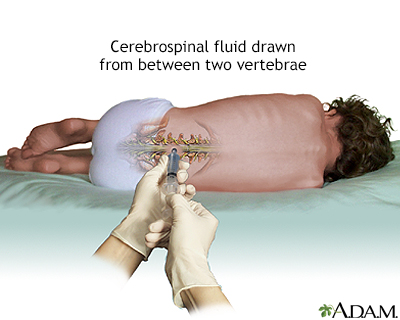CSF myelin basic protein
CSF myelin basic protein is a test to measure the level of myelin basic protein (MBP) in the cerebrospinal fluid (CSF).
CSF is a clear liquid that surrounds the brain and spinal cord.
MBP is found in the material that covers many of your nerves.
Images

I Would Like to Learn About:
How the Test is Performed
A sample of spinal fluid is needed. This is done using a lumbar puncture.
Why the Test is Performed
This test is done to see if myelin is breaking down. Multiple sclerosis is the most common cause for this, but other causes may include:
- Bleeding of the central nervous system
- Central nervous system trauma
- Certain brain diseases (encephalopathies)
- Infection of the central nervous system
- Stroke
- Traumatic brain injury
Normal Results
In general, there should be less than 4 ng/mL of myelin basic protein in the CSF.
Normal value ranges may vary slightly among different laboratories. Talk to your health care provider about the meaning of your specific test results.
The example above shows the common measurement result for this test. Some laboratories use different measurements or may test different specimens.
What Abnormal Results Mean
Myelin basic protein levels from 4 to 8 ng/mL may be a sign of a long-term (chronic) breakdown of myelin. It may also indicate recovery from an acute episode of myelin breakdown.
If the myelin basic protein level is 9 ng/mL or greater, myelin is actively breaking down.
Related Information
MyelinMultiple sclerosis
Stroke
Spinal cord trauma
Chronic
Acute
References
Euerle BD. Spinal puncture and cerebrospinal fluid examination. In: Roberts JR, Custalow CB, Thomsen TW, eds. Roberts and Hedges' Clinical Procedures in Emergency Medicine and Acute Care. 7th ed. Philadelphia, PA: Elsevier; 2019:chap 60.
Fabian MT, Krieger SC, Lublin FD. Multiple sclerosis and other inflammatory demyelinating diseases of the central nervous system. In: Jankovic J, Mazziotta JC, Pomeroy SL, Newman NJ, eds. Bradley and Daroff's Neurology in Clinical Practice. 8th ed. Philadelphia, PA: Elsevier; 2022: chap 80.
Karcher DS, McPherson RA. Cerebrospinal, synovial, serous body fluids, and alternative specimens. In: McPherson RA, Pincus MR, eds. Henry's Clinical Diagnosis and Management by Laboratory Methods. 24th ed. Philadelphia, PA: Elsevier; 2022:chap 30.
BACK TO TOPReview Date: 4/29/2023
Reviewed By: Joseph V. Campellone, MD, Department of Neurology, Cooper Medical School of Rowan University, Camden, NJ. Review provided by VeriMed Healthcare Network. Also reviewed by David C. Dugdale, MD, Medical Director, Brenda Conaway, Editorial Director, and the A.D.A.M. Editorial team.

Health Content Provider
06/01/2025
|
A.D.A.M., Inc. is accredited by URAC, for Health Content Provider (www.urac.org). URAC's accreditation program is an independent audit to verify that A.D.A.M. follows rigorous standards of quality and accountability. A.D.A.M. is among the first to achieve this important distinction for online health information and services. Learn more about A.D.A.M.'s editorial policy, editorial process and privacy policy. A.D.A.M. is also a founding member of Hi-Ethics. This site complied with the HONcode standard for trustworthy health information from 1995 to 2022, after which HON (Health On the Net, a not-for-profit organization that promoted transparent and reliable health information online) was discontinued. |
The information provided herein should not be used during any medical emergency or for the diagnosis or treatment of any medical condition. A licensed medical professional should be consulted for diagnosis and treatment of any and all medical conditions. Links to other sites are provided for information only -- they do not constitute endorsements of those other sites. © 1997- 2024 A.D.A.M., a business unit of Ebix, Inc. Any duplication or distribution of the information contained herein is strictly prohibited.
